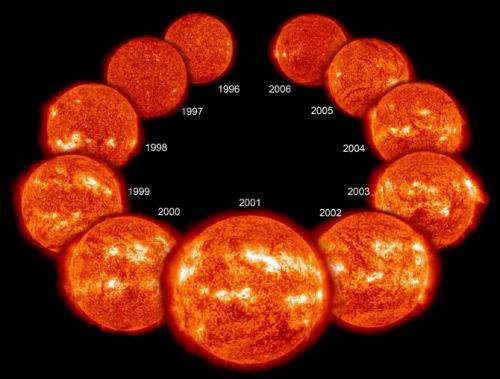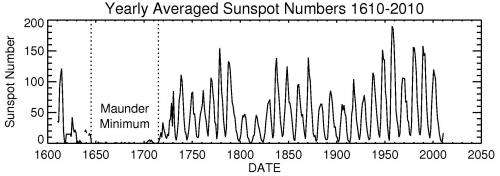Solar cycle primer

(PhysOrg.com) -- Telescopes spotted the first blemish on the sun in 1611. While the sun had long been thought—at least in the Western world—to be an unchanging, "perfect" orb, sky-watchers observed black sunspots on the sun's surface that circled around as with the sun's rotation.
That first crack in the theory of the sun's immutable nature would soon fracture completely as the number of sunspots were shown to increase and decrease over time in a regular, approximately 11-year cycle, called the sunspot cycle. The exact length of the cycle can vary. It has been as short as eight years and as long as fourteen, but the number of sunspots always increases over time, and then returns to low again.
More sunspots mean increased solar activity, when great blooms of radiation known as solar flares or bursts of solar material known as coronal mass ejections (CMEs) shoot off the sun's surface. The highest number of sun spots in any given cycle is designated "solar maximum," while the lowest number is designated "solar minimum." Each cycle varies dramatically in intensity with some solar maxima being so low as to be almost indistinguishable from the preceding minimum.
One such set of cycles famously occurred from 1645 to 1715 and is known as the Maunder Minimum. Those who watched the sun could count enough change in sunspot number that they could still track cycles, but the overall sunspot number dropped drastically. One thirty-year period showed only 30 sunspots, one thousandth of what is typically seen.
The timing of the Maunder Minimum corresponded to what's called the Little Ice Age in Europe—a time of colder weather, heavier snowfall and the freezing of unusually large bodies of water such as the Thames and even the Baltic Sea. The Little Ice Age lasted longer than the Maunder Minimum, and there are other potential causes. Nevertheless it is believed by many scientists that the prolonged solar minima and its corresponding decrease in solar energy cooled Earth. Mapping out the details of how much the change in solar energy could have produced such an effect remains an unresolved area of research.

It was not until the first half of the 20th century that scientists began to understand what causes the sunspot cycle. Researchers determined that the sunspots were a magnetic phenomenon and that, indeed, the entire sun was magnetized with a north and a south magnetic pole just like a bar magnet. The comparison to a simple bar magnet ends there, however, as the sun's interior is constantly on the move.
By tracking sound waves that course through the center of the sun, an area of research known as helioseismology, scientists can gain an understanding of what's deep inside the sun. They have found that the magnetic material inside the sun is constantly stretching, twisting, and crossing as it bubbles up to the surface. The exact pattern of movements is not conclusively mapped out, but over time they eventually lead to the poles reversing completely.
The sunspot cycle happens because of this pole flip — north becomes south and south becomes north—approximately every 11 years. Some 11 years later, the poles reverse again back to where they started, making the full solar cycle actually a 22-year phenomenon. The sun behaves similarly over the course of each 11-year cycle no matter which pole is on top, however, so this shorter cycle tends to receive more attention.
The sun is currently ramping up once again to solar maximum, so flares and CMEs are more common than they were a few years ago. This cycle may peak in late 2013, or early 2014, and should reach a minimum around 2020—although predictions about the sun's cycle are still quite uncertain. This has been the slowest sunspot cycle of the space age, which is the time frame during which we have the most detailed observations.
The slower-than-expected progress of this cycle has led some researchers to speculate that the next cycle might be even smaller, with few sunspots even at solar maximum. It is still far too early to know, but even if this is the case, it has happened before and isn't a cause for concern. Four hundred years of sunspot observations have shown that the cycle will always return.
More information: For more about sunspots, visit: solarscience.msfc.nasa.gov/SunspotCycle.shtml
Provided by NASA's Goddard Space Flight Center





















